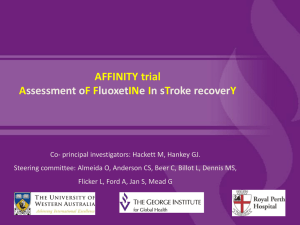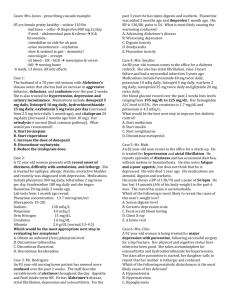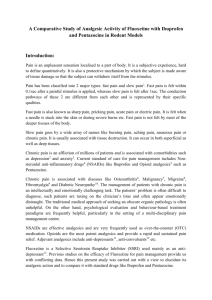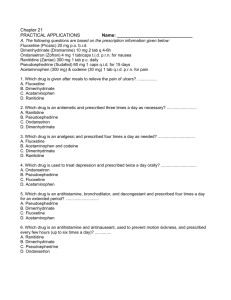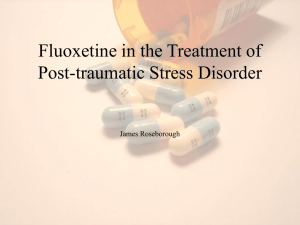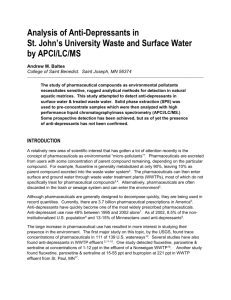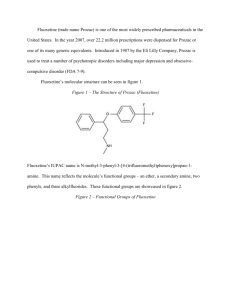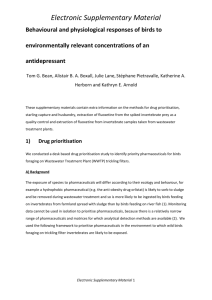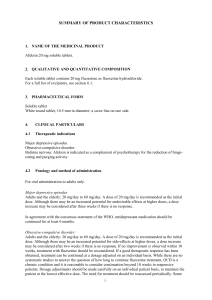Photodecomposition of Fluoxetine
advertisement
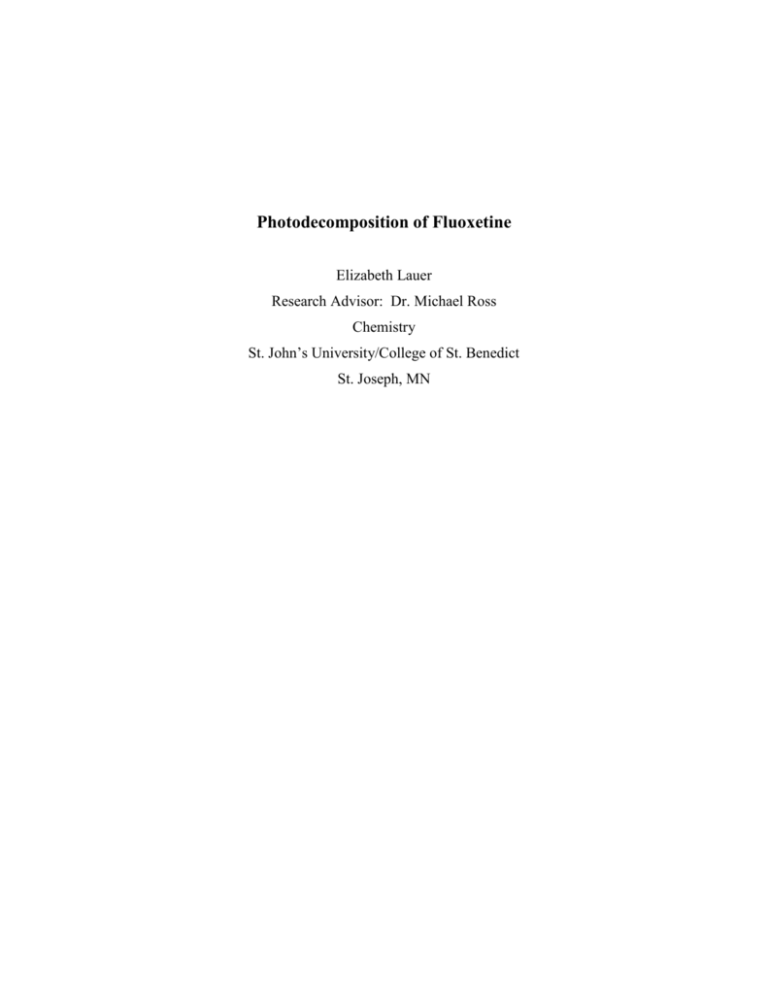
Photodecomposition of Fluoxetine Elizabeth Lauer Research Advisor: Dr. Michael Ross Chemistry St. John’s University/College of St. Benedict St. Joseph, MN Abstract Fluoxetine, also known as Prozac, is a widely marketed selective serotonin reuptake inhibitor, used to fight depression and anxiety. Recently, it has been observed that high levels of this pharmaceutical have been found in water sources prone to contamination. This is a concern for environmental reasons because of the negative effects that it can have on aquatic organisms, including fertility and reproductive problems. In further studies, it has been found that fluoxetine reacts in light, breaking down into various molecules via direct and indirect photolysis, with a half life of 55.2 ± 3.6 hours.7 It was my goal in this study to investigate whether fluoxetine would indeed break down. High performance liquid chromatography and mass spectrometry were used to determine a half life of 66.896 hours in East Gemini Lake water, compared to much higher half lives in buffered solutions. This was evidence that fluoxetine broke down via indirect and/or direct photodecomposition versus simply just direct photodecomposition. Additionally, trials were run in isopropyl alcohol and DABCO to find a mechanism by means of hydroxyl radical or singlet oxygen, respectively. Introduction Fluoxetine, also known as Prozac, is categorized as a selective serotonin reuptake inhibitor (SSRI) with the chemical structure seen in Figure 1. SSRIs selectively inhibit the reuptake of serotonin at the presynaptic neuronal membrane. This could be a result of fluoxetine’s electron withdrawing effect and its lipophilicity. Fluoxetine is used primarily in the treatment of depression and obsessive compulsive disorder. F F F O N H Figure 1: Fluoxetine or N-methyl-8-[4-(trifluoromethyl) phenoxy] benzene propanamine When fluoxetine is metabolized in the body via demethylation, norfluoxetine is formed, which may contribute to the long duration of the action of fluoxetine in the body. Findings indicate that 2.5% of the metabolites analyzed in excreted urine were fluoxetine and 10% norfluoxetine.12 Because this metabolization takes place, as seen in Figure 3, both structures need to be taken into consideration when analyzing for environmental effects. Figure 3: Fluoxetine and its demethylized metabolite, norfluoxetine 12 There have been very few studies done on the environmental effects of nonsteroidal pharmaceuticals, much less anti-depressants. One study done on the toxicity of fluoxetine on select organisms, including aquatic biota such as Ceriodaphnia dubia, Daphnia magna, and Pimephales promelas was conducted. In these experiments, organisms were treated with fluoxetine treatments at various concentrations. Cell deformities occurred, especially seen in algae. Cells appeared shriveled and frequently were not crescent shaped, a normal characteristic of the particular cell being observed. 1 Results also showed that this exposure resulted in fertility problems. In fish, serotonin stimulates the release of gonadotropin in some species, which stimulates sex steroid synthesis and controls the development of oogenesis, including vitellogenesis.1 Other studies have verified that anti-depressants have been found to have the same effect on fish that they do people, they cause aquatic life to be more relaxed. This would suggest that smaller fish would become easier prey for larger fish. This also suggests that if concentrations of drugs, and in particular fluoxetine, are high enough they could cause catastrophic results for the ecosystem. In this study, the goal was to see if fluoxetine would break down in water with the understanding that it is present currently in many bodies of water throughout the United States as well as Canada. Previous studies indicated that fluoxetine broke down in sunlit water, resulting in a half life of 55.2 ± 3.6 hours7. Finding out whether fluoxetine decomposed via direct and indirect photolysis was the primary goal. Direct photolysis is when a compound absorbs light, becomes unstable, and decomposes. Indirect photolysis occurs when a reactive intermediate is generated by another light absorbing material and then causes a compound to decompose. Using this information, the objective was to find a half life of fluoxetine and if possible, a mechanism for decomposition. Experimental Chemicals A 10 mM solution of fluoxetine·HCl from the National Science Foundation was prepared using E.Pure water and 3 mL acetonitrile to dissolve. Formate, acetate and ethanolamine buffers were prepared at pH 3, 5 and 9, respectively again using E.Pure water. East Gemini Lake (EGL) water was filtered using 0.45 µm filter paper. Solutions were also made of 100 μM fluoxetine in an ethanolamine buffer of pH 8.5, EGL water, EGL water with isopropyl alcohol (IPA) at a concentration of 10-2 M and EGL water with DABCO (1,4-Diazabicyclo[2.2.2]-octane) at a concentration of 10-3 M. Photoreaction Duplicate samples of 100 μM fluoxetine in the respective pH 3, 5, 9 and EGL lake water were prepared and put into quartz test tubes. Similar samples were wrapped in aluminum foil to serve as controls for the experiment. The photoreacter was comprised of a 450 W UV immersion lamp from Ace Glass Incorporated surrounded by quartz immersion lamp well that continuously had cold water running through it. The samples were run around the lamp powered by a generator. A diagram of this setup can be seen in Figure 4. Aliquots of 750 μL were taken from the test tubes at various time intervals for approximately 70 hours. Samples were run under the previous conditions; however the solutions of 100 μM fluoxetine were in the ethanolamine buffer of pH 8.5, EGL water, EGL water with isopropyl alcohol and EGL water with DABCO at concentrations previously specified. Controls of the same nature were also provided. Figure 4: Diagram of the photoreactor used for photolysis of fluoxetine Analysis was performed using liquid chromatography/mass spectrometry (LC/MS). This instrument was a Surveyor photodiode array (PDA) Detector, Autosampler, LC Pump, followed by an LCQ Advantage mass spectrometer, all produced by Thermo Finnigan. The conditions of the LC were as follows: a stationary phase of Synergi 4u MAX-RP 80A 150x4.6 mm column was used with a mobile phase of 60% acetonitrile and 40% pH 5 acetate buffer. An electron Spray Ionization (ESI) source was used on the mass spectrometer. Results and Discussion 0 0 20 40 60 80 log (A/A0) -0.05 pH 3-dark -0.1 pH 3 Linear (pH 3-dark) -0.15 Linear (pH 3) -0.2 y = -0.0009x - 0.0897 y = -0.002x - 0.0637 -0.25 Time (hours) Figure 5: Results of the photodecomposition of fluoxetine at pH 3 using, resulting in a half life of 150.515 hours 0 0 20 40 60 80 log(A/A0) -0.05 -0.1 pH 5-dark pH 5 -0.15 Linear (pH 5-dark) -0.2 Linear (pH 5) -0.25 y = -0.0008x - 0.092 y = -0.0022x - 0.1108 -0.3 Time (hours) Figure 6: Results of the photodecomposition of fluoxetine at pH 5, resulting in a half life of 136.832 hours 0.05 0 log(A/A0) -0.05 0 20 40 60 80 pH 9-dark -0.1 pH 9 Linear (pH 9-dark) -0.15 Linear (pH 9) -0.2 -0.25 y = -0.0018x - 0.0182 -0.3 y = -0.0028x - 0.0809 Time (hours) Figure 7: Results of the photodecomposition of fluoxetine at pH 9, resulting in a half life of 107.511 hours 0.05 0 log(A/A0) -0.05 0 20 40 60 80 -0.1 EGL-dark -0.15 EGL Linear (EGL-dark) -0.2 Linear (EGL) -0.25 -0.3 -0.35 y = -0.0037x - 0.0053 -0.4 y = -0.0045x - 0.0191 Time (hours) Figure 8: Results of the photodecomposition of fluoxetine in East Gemini Lake water, resulting in a half life of 66.896 hours In order to find the half life of fluoxetine in the various conditions, a line of best fit was found for each set of data, as seen in Figures 5 through 8. From this data, the slope of the line represented the negative of the rate constant. Using the rate constant, the half life was found from the following equation: -log(1/2) = -kt. The data used to find this information was found using the analysis method of mass spectrometry (MS) chromatograms instead of the photodiode array (PDA) chromatograms. The reasoning for this was that the MS analysis provided much better quantitation for fluoxetine. The PDA chromatograms were not as precise and therefore not used. Solution Half Life (hours) pH 3 150.515 pH 5 136.832 pH 9 107.511 EGL 66.896 Table 1: Half lives (in hours) of fluoxetine based on the solution they were in during photodecomposition These half lives provided valuable information. The primary purpose of the experiment was to find out whether fluoxetine photodecomposed via direct or indirect photolysis. From the information seen in Table 1, one can see that there was a trend in the photodecomposition as the pH of the buffer used became more basic, indicating that there was a possible dependence on pH. Another similarity shows that the pH of EGL water is approximately at a pH of 8.5, showing a direct correlation between the pH 9 buffer and EGL water. Another deduction that can be made from the combined results in Table 1 is that photolysis occurred much faster in the EGL water, with a half life of 66.896 hours. This signifies that fluoxetine did not break down solely by direct decomposition; there must have been a mixture of direct and indirect decomposition. Again, during indirect photolysis there are organic molecules in solution that are excited by light absorption and thus cause the breakdown of fluoxetine versus direct photolysis where fluoxetine absorbs light and breaks down directly. After finding that although fluoxetine decomposes at a rather slow rate, it does indeed decompose. Another goal of the experiment was to propose a mechanism by which fluoxetine photodecomposed. Two very common mechanisms of indirect photodecomposition include photodecomposition by hydroxyl radical (●OH) and singlet oxygen (1O2). Trials run with isopropyl alcohol will cause the consummation of any hydroxyl radical in solution. If indirect photolysis occurs by hydroxyl radical, the fluoxetine will not decompose in trials ran in the presence of isopropyl alcohol. Trials run with DABCO will similarly consume any singlet oxygen present in solution and if indirect photolysis occurs by singlet oxygen, the fluoxetine will not decompose in the presence of DABCO. These two chemicals and the mechanism by which they prevent photodecomposition are termed “scavengers.” Solution Half Life (hours) pH 9 200.687 EGL 130.883 EGL with IPA 125.429 EGL with DABCO 301.030 Table 2: Half lives (in hours) of fluoxetine based on the solution they were in during photodecomposition Preliminary results of the investigation of the mechanism by which fluoxetine photodecomposes have shown that a mechanism via singlet oxygen is possibly favorable. This can be seen in the results found in Table 2, where the EGL water with IPA produced a half life of 125.429 hours and EGL water with DABCO produced a half life of 301.030 hours. As previously stated before, fluoxetine would not decompose in the presence of a certain scavenger (IPA or DABCO) if fluoxetine photodecomposed via that mechanism. However, because these are strictly introductory studies, further research needs to be performed in order to solidify these results. Future Research There are many other future areas of research that could be explored using fluoxetine. There are possibilities of more trials run with IPA and DABCO that could be performed in order to see if singlet oxygen is indeed a true mechanism. If neither of the two scavengers proposed are the cause of photodecomposition, other possible organic molecules could be in solution acting as reactive intermediates causing the photodecomposition of fluoxetine. Another trend that was seen was the dark (control) for all of the different solutions of buffer as well as the EGL water also decomposed. Running trials where fluoxetine would not be exposed to any sort of light and not put into the photoreactor could be tried to see if there is some other mechanism other than one involving light absorption that causes the decomposition of fluoxetine. Environmentalists are concerned because of the immediate effects that fluoxetine has on the environment that have already been researched. Additionally, another concern is to identify the exact photodecomposed products because it is possible that these byproducts could be harmful to the environment and aquatic life as well. Lastly, norfluoxetine, the metabolite that fluoxetine forms in the body by a demethylation, could be researched under all of the same conditions as above since it is present in higher concentrations in the urine of patients taking fluoxetine. Conclusion The half life of fluoxetine was found to be 66.896 hours in East Gemini Lake water. A proposed mechanism via singlet oxygen is in the beginning stages of research and other avenues of research are proposed for the study of the photodecomposition fluoxetine. There are special acknowledgements to Dr. Michael Ross for expertise advise during this research project, as well as the College of Saint Benedict/Saint John’s University Chemistry Department for additional support. References 1 Brooks, B.W., Turner, P.K., Stanley, J.K., Weston, J.J., Glidewell, E.A., Christy, M.F., Slattery, M., La Poin, T., Huggett, D.B., Waterborne and sediment toxicity of fluoxetine to select organisms. 2003. Chemosphere 52, p. 135-142. 2 Dr. Reddy’s Laboratories Limited, Fluoxetine capsules USP. August 2002. 3 El-dawy, M.A., Mokhtar, M.M., El-Barbary, F.A., Liquid chromatographic determination of fluoxetine. 2002. Journal of Pharmaceutical and Biomedical Analysis, p. 1-11. 4 Fay, R.C., McMurry, J., Chemistry, Third Edition. 2001. Prentice-Hall, Inc. Upper Saddle River, New Jersey, p.484-498 5 Garden, D., Chromatograph Column: Imported Chromatograph Analysis Column. FLM-TJ Technology Development Co., Ltd. 2005. 6 Johnston, R., Fluoxetine (Prozac). 2003. www.chemistry.clemson.edu 7 Lam, M.W., Young, C.J., Mabury, S.A., Aqueous Photochemical Reaction Kinetics and Transformations of Fluoxetine. 20 October 2003. Evironmental Science & Technology. American Chemical Society. 8 Stahl, S.M., Essential Psychopharmacology, 2nd Ed., Cambridge University Press, New York, 2000. 9 Streater, S., Drug found in area fish stirs concern.17 October 2003. Star-Telegram. www.dfw.com 10 Walton, M., Frogs, fish and pharmaceuticals a troubling brew. 14 November 2003. Cable News Network LP, LLLP. www.cnn.com 11 Wirth, D.D., Miller, M.S., Bioni, S.K., Koenig, T.M., Identification and comparison of impurities in fluoxetine hydrochloride synthesized by seven different routes. 2000. American Chemical Society and Royal Society of Chemistry. 12 Wong, S.H.Y., Dellafera, S.S., Fernandes, R., Kranzler, H., Determination of fluoxetine and norfluoxetine by high performance liquid chromatography. 1990. Journal of Chromatography 499, p. 601-608.
